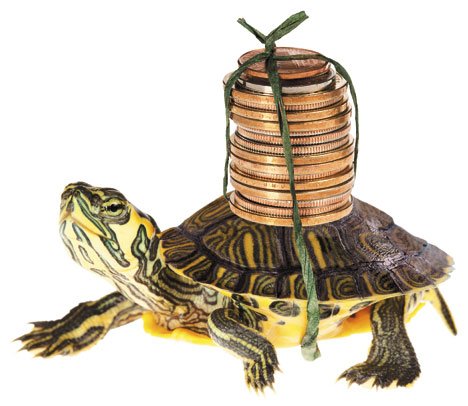
A lot of people blame fast-buck artists for bringing on the 2008 economic crash, but few have yet looked to Slow Money artistry to undo the problem. You want to do something unusually powerful? Help build slowcialism.
It’s a movement that started when the market plunge gave New Mexico social investment promoter Woody Tasch an aha moment. Modelling his efforts on the success of Slow Food, he formed the Slow Money Alliance and wrote Inquiries Into The Nature Of Slow Money: Investing As If Food, Fertility And Farms Mattered, which quickly tweaked the imagination of social investors, community development advocates and even business journalists.
The deep thinking behind Slow Food, over and above its appeal to gourmets who appreciate exquisite dining, also underlies Slow Money. Just as slow dining is good for heartburn and other digestive ills in a fast food culture, so slow returns on investment aid economic digestion and ensure that benefits are spread properly through the system.
That may be because today’s money not only talks, as it always has, but is a very fast talker. Indeed, this speed-up is as signature a feature of the political economy of the last 20 years as are globalization and free trade, and for the very good reason that all three are interlocked.
Cute and disarming as the term Slow Money seems, the notion confronts one of the most powerful impulses in today’s economy, the demand for ever-faster turnover of investment. Ironically, investment speed is a major factor in the present chronic slowdown of the global economy – a recession so far resistant to the trillions spent by global North governments on economic stimulus.
I’ve been a slow learner in these matters, but my mind got blown to this way of thinking at a holiday dinner party thanks to my formidably well-read friend, U of T food scholar Harriet Friedmann. She was shocked that I couldn’t participate in cocktail conversation about the Mann-Dickinson thesis laid out in a 1978 issue of the Journal of Peasant Studies.
When I confessed that that edition was not to be found on my bedside table, she generously dispatched it to me. Ever the quick study, I converted immediately to the idea of slowing the turnover time of money to the pace set by that quintessentially high-return growth fund – nature.
The Mann-Dickinson thesis holds that factories succeed because the labour time and production time to make a widget are the same. By contrast, food production, education, parenting and the like are time-inefficient. Growing wheat takes a year creating adults 18 to 30 years. The longer the production time, the more likely the enterprise is non-profit or non-profitable, because money is “tied up” for too long.
Since the 1990s, the entire economy and infrastructure have been bent to the task of reducing production time and circulation time. We have chicken meat that goes from egg to supermarket in three weeks, and trucks practise just-in-time delivery so no money is lost on warehousing or interest charges.
But the transaction costs borne by nature and the general public for this rapidity are staggering: antibiotics and tiny cages are the norm in chicken factory farms so no calories are wasted on immune systems or exercise the repair costs to highways trafficked at such a hectic pace are exorbitant, as are the fast-food-induced costs of health care. When productivity is defined in terms of output per hour, the true costs are hidden and speed is embedded at the centre of global accounting systems.
By and large, fast infrastructure and government policy discourage the multiplier effect, as in “I get a haircut from a local barber who spends the money at a grocer who buys from the farmer down the lane, and so on.” By contrast, money that goes to a typical chain is whisked out of the economy, often within 24 hours, according to David Boyle and Andrew Simms’s just-released The New Economics: A Bigger Picture.
With highly processed products like wine, the multiplier is staggering. According to a 2008 report by accounting firm KPMG, a litre of Ontario wine sold in Ontario puts $8.48 back in the economy, compared to 67 cents from an import.
It doesn’t take a quick thinker to pause at that exposé of quick and dirty money.
Calming fast money
People turn locavore for enviro and community reasons, but here’s the added bonus: it helps to create stickiness in the distorted global economic system.
> Sign on to the Slow Money principles at slowmoney.org
> Invest 1 per cent of your assets in nearby food systems, as advocated by the Slow Money Alliance
> Slow global cash by lobbying for the Tobin tax, a fee on global financial transactions
> Lobby for speed taxes such as higher road and carbon taxes
> Take the Local Food Plus pledge to spend $10 weekly on local, sustainable eats
> Give the economic system breathing space by buying second-hand
> Shop at independent retailers, not chains
> Find specialty repair folks so you don’t have to buy new
news@nowtoronto.com












